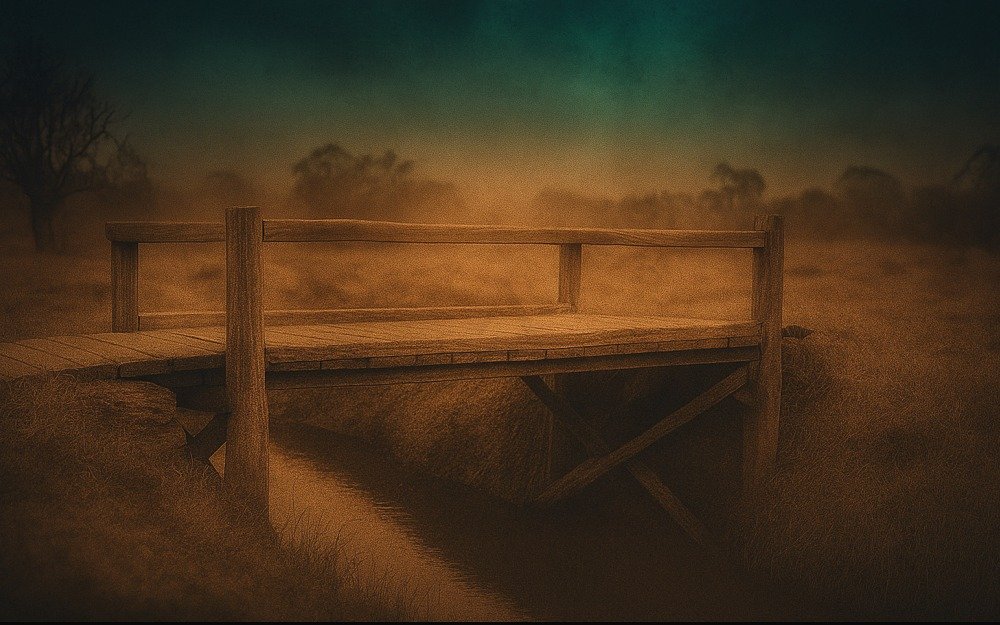
In 1826, a man vanished from Campbelltown. Weeks later, a ghost was said to appear on a bridge — pointing toward a paddock where the missing man’s body would soon be found. The case became known as Fisher’s Ghost. It is one of Australia’s earliest recorded ghost stories, and one of the few where a spectral account preceded a murder conviction. The ghost’s testimony was never entered into the legal record, but it shaped public sentiment and triggered a formal investigation.
The Disappearance of Frederick Fisher
Frederick Fisher was a well-known figure in Campbelltown — respected, though not without blemish. A former convict turned landowner, Fisher had recently entrusted his affairs to George Worrall, a friend and fellow ex-convict, while serving a brief sentence for forgery. Upon his release, Fisher resumed control of his property, but tensions lingered.
On 17 June 1826, Fisher vanished. Worrall claimed Fisher had returned to England, leaving him power of attorney. The story raised eyebrows. Fisher’s affairs were in order, his departure abrupt. Neighbours grew uneasy. Whispers spread. Something was wrong.
The Ghost on the Bridge
Weeks passed. Then came the sighting.
John Farley, a local man, claimed he saw Fisher’s ghost sitting on a rail near a creek — now the site of Fisher’s Ghost Bridge. The apparition, Farley said, pointed toward a paddock behind the property. Farley was shaken. He told authorities.
At first, his story was dismissed. Ghosts were not admissible. But the location lingered in the minds of investigators. Soon, physical evidence surfaced — blood stains, a tooth, and strands of hair found by local boys near the creek. The paddock beckoned.
The Search and the Tracker
Constable William Henslowe called in an Aboriginal tracker from Liverpool — a man known for his skill in reading the land. The tracker examined the site, tested puddles, and declared: “White fellow’s fat here.” His words pointed to decomposition. The search intensified.
Fisher’s body was found in a shallow grave behind Worrall’s property. The remains showed signs of violence. The ghost’s gesture, Farley’s account, and the tracker’s intuition had converged. Worrall was arrested.
The tracker’s name was not recorded. His role was practical, not ceremonial — called in to read the land when others could not. His words shifted the search from speculation to action.
The Trial and Conviction
George Worrall was charged with the murder of Frederick Fisher. His account — that Fisher had returned to England — began to unravel. Neighbours took note of his sudden control over Fisher’s property, and inconsistencies in his story gave the case momentum. The case went to trial. Worrall stood before a jury in Sydney, where the ghost story — known to all — lingered in the background but was never formally entered into evidence.
The jury found Worrall guilty. He was sentenced to death and hanged in Sydney in 1827. The conviction rested on physical evidence and inconsistencies — but the ghost had shaped the investigation.
Ghost Story Reception
Farley’s account was met with skepticism by some, but it spread quickly. Some dismissed it as theatre. Others saw it as a warning. The ghost’s gesture lingered — not in court, but in conversation.
Colonial Folklore and Legal Ambiguity
Ghost stories weren’t part of the legal process in colonial New South Wales, but they weren’t ignored either. Farley’s account moved through the community — spoken about, questioned, and remembered. Whether it began as a genuine report or something else isn’t known.
The case invites comparison to the Greenbrier Ghost Trial in West Virginia, where a spectral account led to an exhumation and eventual conviction. In both instances, the ghost was not legal evidence — but it prompted formal inquiry.
Legacy and Cultural Memory
The story of Fisher’s Ghost didn’t stop with the trial. It settled into Campbelltown’s public memory — taught in schools, retold in conversation, and marked in local tradition.
Since 1956, the town has hosted the Festival of Fisher’s Ghost each November. It includes parades, art prizes, and storytelling events. The festival doesn’t try to prove the ghost was real. It simply acknowledges the story’s place in Campbelltown’s history. The crossing where Farley said he saw the ghost is still marked, and the paddock behind it remains part of the landscape.
Festival Origins
The festival began quietly — a civic nod to the story and its place in Campbelltown’s past. Over time, it grew. Art prizes were added. Performances followed. The ghost remained part of the celebration, but the event widened to include broader reflections on local history.
Editorial Restraint: Marking the Myth
Fisher’s death was real. The body was found. The ghost remains unverified — but culturally persistent.
The ghost never entered the legal record. Its role remained informal — spoken about, never sworn. While the story has not been debunked, some suggest Farley may have known the location of Fisher’s body and used the ghost account to avoid implication. This theory remains unproven.
History’s Vault sees this tale as folklore with legal implications — a case where cultural sensitivities influenced colonial justice.
🔗 Think that was strange? There’s more. Explore our full Unexplained Events Archive.
References
[1] Campbelltown City Council. The Legend of Fisher’s Ghost. Retrieved 7 October 2025.
[2] Visit Campbelltown. The Legend of Fisher’s Ghost. Retrieved 7 October 2025.
[3] FabulaHub. The Story of Fisher’s Ghost. Retrieved 7 October 2025.
[4] History’s Vault. The Ghost Who Testified: Zona Heaster Shue and the Greenbrier Murder Trial. Retrieved 7 October 2025.
